#practical exercises
Text
"Unveiling the Unseen: A Profound Exploration of 'Clairvoyance and Occult Powers' by Swami Panchadasi"
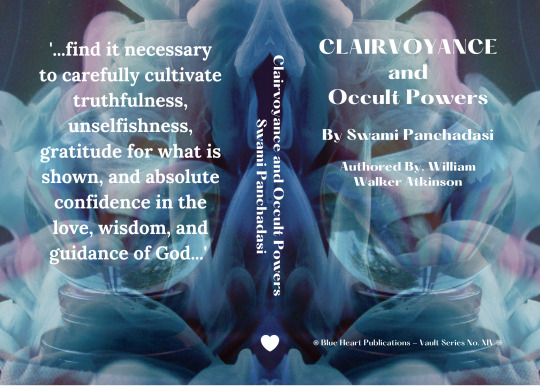
Title: "Unveiling the Unseen: A Profound Exploration of 'Clairvoyance and Occult Powers' by Swami Panchadasi"
Swami Panchadasi's (A.K.A. Atkinson, William Walker) "Clairvoyance and Occult Powers" beckons readers into the enigmatic realms of extrasensory perception and mystical abilities. As I delved into the pages of this esoteric work, I found myself immersed in a fascinating journey through the intricacies of clairvoyance, the third eye, and the untapped potentials of the human mind. The title alone promises a profound exploration of occult powers, and Swami Panchadasi does not disappoint.
At the heart of the book lies an in-depth exploration of clairvoyance, the ability to perceive beyond the limitations of the physical senses. Swami Panchadasi, drawing upon his deep knowledge of Eastern mysticism, unveils the secrets of developing and harnessing this psychic faculty. His teachings guide readers through the nuances of opening the third eye, awakening dormant powers, and tapping into the unseen forces that permeate our existence.
One of the notable strengths of Panchadasi's work is its accessibility. Despite delving into intricate metaphysical concepts, the author presents the material in a manner that is comprehensible to both novices and seasoned practitioners. The step-by-step instructions and practical exercises provided serve as a roadmap for individuals seeking to cultivate their latent psychic abilities.
The book also delves into various occult powers beyond clairvoyance, offering insights into telepathy, psychometry, and the manipulation of vital life forces. Panchadasi's approach is not merely theoretical; he provides practical exercises and guidance, inviting readers to embark on a personal journey of self-discovery and spiritual development.
What sets "Clairvoyance and Occult Powers" apart is its blend of Eastern mysticism and Western occultism. Swami Panchadasi draws from a diverse range of spiritual traditions, creating a synthesis that resonates with a broad audience. The inclusion of anecdotes, case studies, and historical references adds depth to the narrative, illustrating the universality of these mystical experiences.
While the subject matter may challenge conventional beliefs, Panchadasi approaches it with a sense of reverence and responsibility. The emphasis on ethical considerations and the cautionary advice regarding the use of occult powers underscore the author's commitment to guiding readers toward a balanced and mindful exploration of these mystical realms.
In conclusion, "Clairvoyance and Occult Powers" by Swami Panchadasi is a captivating exploration of the unseen dimensions of human potential. Whether one approaches it with skepticism or an open mind, the book offers a thought-provoking journey into the realms of the mystical and the metaphysical. Panchadasi's lucid prose, coupled with practical exercises, makes this work an invaluable resource for those curious about unlocking the hidden potentials of the mind and delving into the mysteries that lie beyond the veil of the material world.
Swami Panchadasi's (A.K.A. Atkinson, William Walker) "Clairvoyance and Occult Powers" is available in Amazon in paperback 14.99$ and hardcover 22.99$ editions.
Number of pages: 324
Language: English
Rating: 10/10
Link of the book!
Review By: King's Cat
#Swami Panchadasi#Clairvoyance#Occult powers#Third eye#Extrasensory perception#Mystic abilities#Eastern mysticism#Psychic faculties#Spiritual development#Metaphysical exploration#Practical exercises#Mystical experiences#Awakening the third eye#Psychometry#Telepathy#Vital life forces#Eastern and Western occultism#Self-discovery#Ethical considerations#Unseen dimensions#Hidden potentials#Mind-body connection#Occult practices#Astral perception#Meditation techniques#Metaphysical concepts#Personal transformation#Mystical traditions#Practical guidance#Spiritual growth
4 notes
·
View notes
Text
Unlock Your Potential: Join Our Exclusive 1-Day Workshop!
Register Now
Are you ready to elevate your skills and unlock new opportunities? Strategia Advizo, in collaboration with Tilka Manjhi Bhagalpur University, is thrilled to announce an exclusive one-day workshop designed specifically for MBA and M.Com students. Scheduled for the first week of April 2024, at the university seminar hall, this series promises to be a game-changer for your professional…

View On WordPress
#Accounting and Taxation#April 2024 Event#Business Skills#Certificate Program#digital marketing#Future Leaders#Industry Trends#Networking Opportunity#Payroll Management#Practical Exercises#Professional Development#Strategia Advizo#Student Engagement#University Collaboration#Workshop
0 notes
Text
"Beyond the Veil: Illuminating 'The Human Aura' by Swami Panchadasi (William Walker Atkinson)"

Swami Panchadasi, the pseudonym for the prolific William Walker Atkinson, beckons readers into the ethereal realm of metaphysics and mysticism with his profound work, "The Human Aura: Astral Colors and Thought Forms." This timeless exploration of the invisible energies that surround and emanate from the human body offers a captivating journey into the esoteric dimensions of our existence. The title alone hints at the unveiling of the unseen, promising a rich tapestry of insights into the intricacies of the human aura.
Atkinson's expertise in the realms of mysticism and the occult is evident as he guides readers through the subtle yet profound aspects of the human aura. The aura, believed to be an electromagnetic field that encapsulates the physical body, is described in vivid detail by Panchadasi. The astral colors and thought forms, according to his teachings, provide a visual representation of an individual's emotional, mental, and spiritual state.
The language employed by Panchadasi is both accessible and poetic, allowing readers to grasp the complexities of metaphysical concepts without feeling overwhelmed. The intricacies of astral colors, thought vibrations, and the interplay between the physical and spiritual realms are presented in a manner that invites contemplation and introspection.
One of the notable strengths of "The Human Aura" is its practical approach. Panchadasi not only describes the theory behind the human aura but also provides exercises and techniques for readers to develop their own sensitivity to these subtle energies. The inclusion of practical applications enhances the book's value, allowing readers to engage with the material on a personal level.
The title characterizes the human aura as a dynamic canvas that reflects the inner workings of the mind and spirit. Panchadasi introduces readers to the idea that thoughts and emotions are not mere intangible concepts but possess a tangible existence in the form of vibrant colors within the aura. This perspective encourages individuals to become more attuned to their inner states and, subsequently, take charge of their spiritual and mental well-being.
However, it is essential to approach Panchadasi's work with an open mind, recognizing that the exploration of the aura and thought forms is rooted in esoteric traditions. The book delves into areas that might challenge conventional beliefs, urging readers to broaden their perspectives on the nature of reality and the interconnectedness of the physical and metaphysical realms.
In conclusion, "The Human Aura: Astral Colors and Thought Forms" by Swami Panchadasi, alias William Walker Atkinson, is a captivating odyssey into the unseen dimensions of human existence. The title, with its promise of exploring astral colors and thought forms, encapsulates the essence of the work. Panchadasi's eloquent prose, coupled with practical exercises, invites readers to embark on a personal journey of self-discovery and heightened awareness. As one delves into the pages of this mystical masterpiece, the invisible threads of the human aura are unraveled, revealing a world that transcends the limits of the physical and invites us to contemplate the boundless potential of the human spirit.
"The Human Aura: Astral Colors and Thought Forms." , is available in Amazon in paperback 12.99$ and hardcover 18.99$ editions.
Number of pages: 91
Language: English
Rating: 8/10
Link of the book!
Review By: King's Cat
#Swami Panchadasi#William Walker Atkinson#The Human Aura#Astral Colors#Thought Forms#Metaphysics#Mysticism#Esoteric traditions#Invisible energies#Spiritual exploration#Vibrant colors#Inner states#Astral dimensions#Electromagnetic field#Spiritual well-being#Practical exercises#Introspection#Personal development#Esoteric insights#Metaphysical concepts#Inner workings of the mind#Subtle energies#Dynamic canvas#Spiritual journey#Mind and spirit#Open-minded exploration#Interconnectedness#Unseen dimensions#Transcendental experiences#Spiritual awakening
0 notes
Link
#self-help#positivity#women empowerment#Nina Madsen#personal growth#resilience#self-care#motivational reading#practical exercises#positive mindset#self-love#inspirational guide#quick read#self-improvement#mental wellness#uplifting content#empowerment literature#ersonal development#self-help books for women#positive thinking
1 note
·
View note
Text

658 notes
·
View notes
Text

bunny snoopy :p
#snoopy#snoopy fanart#cottagecore#bunny#fanart#also that was kind of a practice exercise again lol#just reposting here dont mind me
465 notes
·
View notes
Text
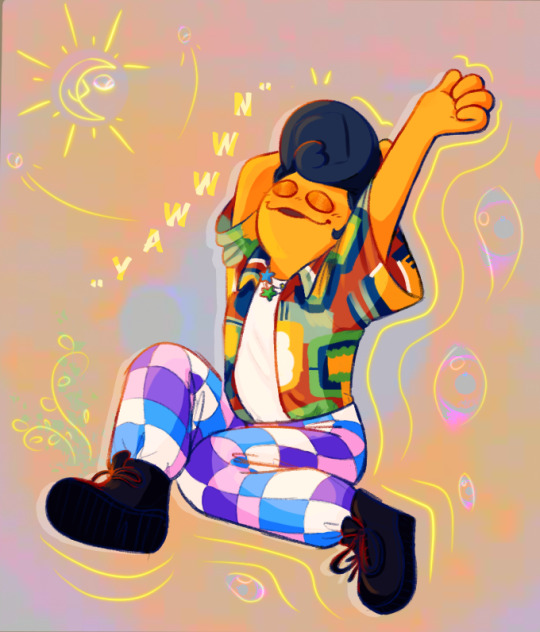


second batch of outfit requests!
pattern collage / showfit / clownfit for @koifsssh & candy cardigan Eddie for @jazzzzzzhands <3
#thank you for the Looks! <3#this little Exercise is pushing me out of my comfort zone with poses tbh#in a really good way!!#im learning stuff! im improving day-to-day in little ways#its the small victories i think. good stuff.#scribble garnish#welcome home#welcome home puppet show#figuring out dynamic positions and how to balance weight#also its good clothes practice#historically i have very rarely drawn clothes since yk. im dragon-based#but im slooooowwwwwly getting the hang of folds and creases and the mechanics of different kinds of fabric#that candy cardigan was a Challenge tho my fucking god#it was fun! but difficult.#im fairly satisfied with the result#also sorry eddie's bg is very simple compared to the other ones#they were drawn After i watched spiderverse#& promptly decided to live my art life by the rule:#RANDOM BULLSHIT GO!!!!!#its working for me so far. im getting a lil funky w it. emphasis on Little
1K notes
·
View notes
Text
thinking about how as Aemond’s wife you are the model of perfection.
Your back is straight as you curtsy when you first meet him and hair neatly braided with fine jewels. Your voice is even and never waivers as you speak to him of your family and how grateful they are for this union.
You are intelligent and beautiful, the perfect wife.
It’s why Aemond hardly ever spends time with you.
He bears no ill will toward you, of course. There is no resentment or hatred to his lady wife, but there are no fond feelings either.
He knows of courting and romance, his mother taught him everything from a young age. The poor woman would hold her son’s hands tight and explain that a man must not only respect his wife, but truly cherish her. Love her in the eyes of gods and men. As he grew older he noticed the way his father would wave off her constant advice and concerns until the dreaded night where she was the only one defending him after he lost his eye.
But practice was one thing. When you were nothing but a concept. A figment of Aemond’s imagination when he was ten and marriage was only spoken of during his lessons. Before he lost his eye. Before he heard the ladies of the court whispering about his mutilation and before he watched a whore flinch at the sight of his scarring when Aegon dragged him to a brothel on his thirteenth name day.
He learned then that no matter how much he would love and worship his wife, it would not be returned.
Rather than attempt to force it (he was no brute and had no intentions of doing something so cruel) he simply let you be by yourself.
Yes you were married. You sat by one another at every meal and formal event and on the rare occasion he would even ask for your hand in a dance. But Aemond’s affections toward you were few and far to find.
But there were moments.
Where his icy facade would weaken and you found yourself able to slip through the cracks.
Alicent had told you of his “moments” when the engagement had been announced. The queen herself taking you by the hand as you walked through the garden and explaining gently of Aemond’s condition.
“There are times where he feels a great deal of pain because of the-” She paused, chewing on her cheek while trying to find the most inoffensive way to describe the tragedy that befell her son. “-incident he had as a child.”
You knew enough of it. Many rumors flew through court the day Aemond targaryen walked in with a patch on his eye after Laenor Velaryan’s funeral at driftmark. Some day it was from a sparring incident, others say it was a mark he bore from the first time he mounted the mighty vhaegar. Others say that the Rouge Prince Daemon Targaryen himself gave it to his younger cousin after crude words were exchanged behind closed doors.
You didn’t know what was the truth. Aside from the day the princeling got his scar, was the same he got his dragon.
A fair trade, some would say.
But they didn’t live with the attacks he did.
Nerve damage, is what the maester’s called it when you asked them for more information. His wound may have healed years prior but the prince would continue to live his life with constant bouts of mind-numbing pain brought on by the slightest touch or too sharp of a wind to his cheek.
“Senseless fits.” Aegon called it. When he heard about your curiosity about his brother’s condition he had all but cornered you late at night in the hall. “Anything will set him off and send him throwing a tantrum like a belligerent child. It’s quite entertaining.”
But there’s a moment where the elder brother frowns and you see a shred of concern in his eyes.
“He doesn’t like to be touched during those moments. It makes the pain worse. So if you’re trying to find some way to comfort him I’d recommend you do something else.”
What was ‘something else’ you learned, was simply being there.
Sitting by his side when he curled into himself, trembling fingers reaching out to grab yours and not complaining when his nails dig into the palm of your hand as he cries out in pain. When his breath evens out and the pain subsides, he crawls to you and presses his face to the crook of your neck. He’s far too tired to cover the gnarled scar covering the side of his face but you show no fear or disgust at the sight of it. Your fingers run through his hair, gently combing back the silver tresses and ignoring the tears that stain the shoulder of your gown.
The next morning your husband would wake in your arms and takes a moment to watch your peaceful expression and the way the morning sun kisses your skin.
That day Alicent notices her son sits closer to you at breakfast, speaking softly to you of something she cannot understand. But when she sees his hand reach out and grasp yours, she smiles.
#aemond targaryen x reader#aemond targaryen x you#reminded me of the post about aemond most likely having some sort of nerve damage from losing his eye so- here she be#idk something about composed wives who are just as strong and dangerous if not more than there husband just gets me man#not edited or beta read i just wanted to do a writing exercise to try and clear my mind cause its very blurry atm#this is very wonky wobbly but im trying to keep myself writing even if its silly little things so i dont lose practice yknow!!#for the aemond girlies *passes out*#anyways part two in the 'aemond isnt good at affection' vault because im confident in it#man just assumes you arent attracted to him so he steers clear of you#but is also incredibly protective and a lil jealous
1K notes
·
View notes
Text

All I wanted to do was practice figures in perspective 😂 honestly would have added more for the chaos but I don’t have time
#astro boy#osamu tezuka#tetsuwan atom#traditional art#I guess it is a good exercise to practice drawing the same character with consistent sizing in perspective#But wow the result looks weird
121 notes
·
View notes
Note
*positive vibes intentions and wishes from the other side of earth being sent to you*
Hope you're doing well and if you dont right now i hope you will tomorrow!!! :)))
<33 THANK U FRIEND! i am getting better every day i think 💪
#not having a lot of practice regulating my emotions is a recent struggle i've had to start facing again which has been hard#but ten years of yoga and forcing myself to learn breathing exercises i think will be very helpful!!#and one thing i'd like to also try doing is not giving myself constant psychic damage by going on my phone all the time..#that will be hard but ultimately worth it..#anyway thank u for ur kind message!! i appreciate it#binask
96 notes
·
View notes
Text
DRAWING BACKGROUNDS: TIPS AND TRICKS
So many people are afraid of drawing backgrounds and I think it's a shame, so here's some tips and tricks, because I'm not perfect at it myself but I think the hardest part is really just knowing where to start.
First off: Perspective
Yeah, yeah, that's the scary word. But I promise you, once you're familiar with the basics, backgrounds are a LOT less intimidating. Don't get discouraged if WHEN you have trouble with it. Even professional artists struggle with it. I promise you, screwing it up is good and normal. That's how you learn after all!
Now I'm not going to go into detail on how to do it here, because honestly there are a thousand and one free resources online and in libraries that can explain it far better than I ever could in a singular broad-strokes tumblr post. But I AM at least telling you you should familiarize yourself with these basics:
Important Terms:
Horizon Line: A horizontal line across your canvas, showing your viewer's eye level and providing a location for most of your vanishing points.
Vanishing Point: Integral to drawing in perspective. The sides of a 3D object get smaller as they become farther away from the viewer in space. This point is where the parallel lines of a side eventually meet.
The Basic Types of Perspective:
One Point Perspective: Good for drawing things that you're looking at straight on.
Two Point Perspective: Good for drawing things at an angle.
Three Point Perspective: Good for drawing things the viewer is looking up or down at, especially at an extreme angle.
[Click images for ALT descriptions]

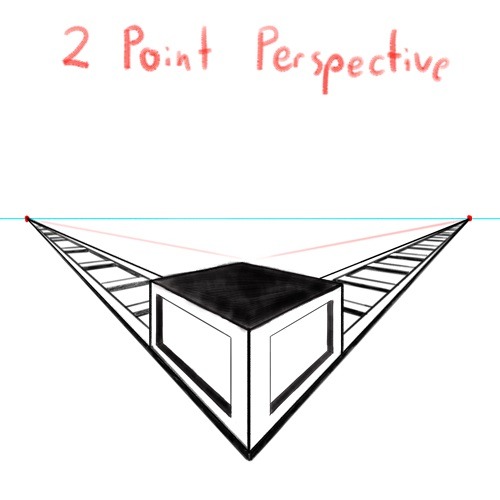
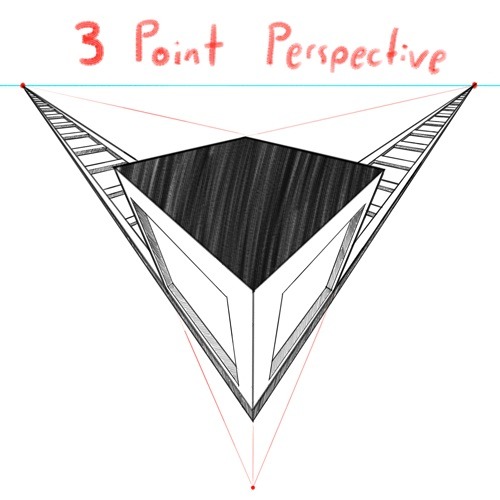
And if you're comfortable with these and serious about improving your skills for use in storytelling, I also might suggest looking up:
4 Point Perspective: Great for extra wide or tall shots and for camera tilts if you're doing an animation or animatic. I think some other names for this in animation include "banana pan" and "warp pan."
5 Point Perspective: Fish-eye lens. Good for all your angsty anime boy slipping into madness needs!
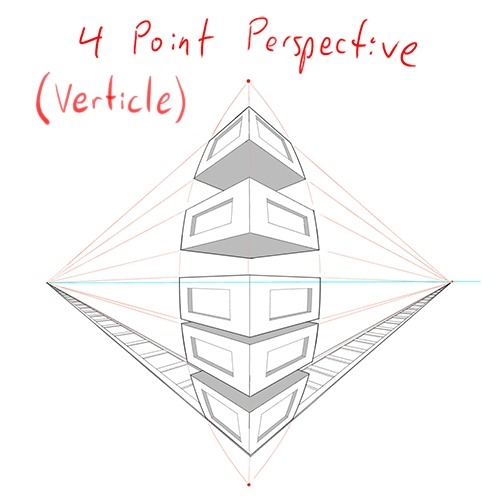
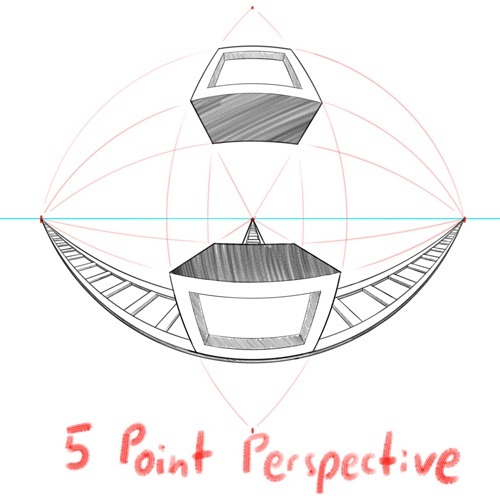
Some perspective tips I wish someone had told me earlier:
Objects' relation to the horizon line is constant.
A super helpful tip to remember when placing a character or object in space is that they will always (assuming they aren't changing in size or moving up or down) have the same relation to the horizon line no matter how far or close they are. If your horizon line is at shoulder height for your focus character in the foreground, any character of the same height in the background will still line up with the horizon line at the shoulders.
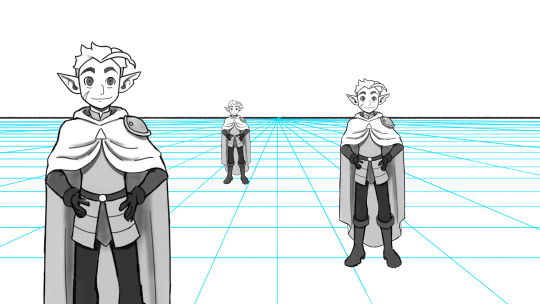
How to pick the distance between your vanishing points:
2 pt perspective uses 2 vanishing points, 3 pt uses 3, etc, etc, but how close should they be? Well, first of all, for anything that isn't one point perspective, one or more points will usually be off the canvas. Super annoying, I know, but the closer your vanishing points are, the more warped your drawing will become.
Second, a helpful thing to know is that choosing the distance between your points is basically the illustration equivalent of picking your camera lens! Photography buffs will know that wider (shorter focal length) lenses show more space and make the distance between foreground and background more dramatic, while longer focal length/telephoto lenses are flatter, and more focused and intimate. The same is true of vanishing points that are closer (shorter focal length) or farther apart (longer focal length).
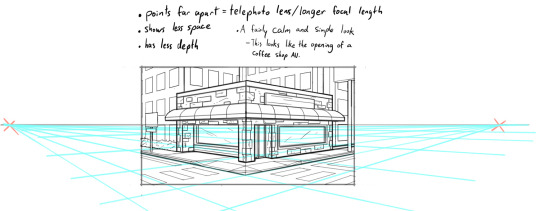
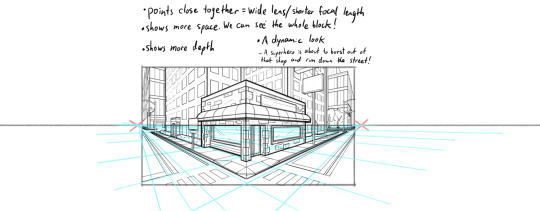
2 point/3 point/etc doesn't actually mean you're limited to that many points total on your page.
this one confused me a lot when I was getting started, lol. A lot of examples will show you drawings of nice, neat cities or something, in which all the buildings are facing the same way in order to demonstrate perspective drawing. But in real life, buildings don't all face the same direction. They're at all sorts of different angles. So how do I do that??? Answer: Just because you're drawing in 2 point perspective or whatever doesn't mean you... have to actually keep your 2 points in the same spot. You can move them around, just keep them the same distance apart, so you're not screwing up your camera lens.
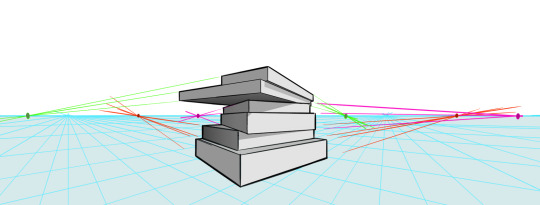
Other Tips:
Use reference!
The instant you try to draw a house, you're going to forget every house you've ever seen. That's just how it goes. Buildings are complicated. Do yourself a favor and collect a few reference images first, buddy!
Consider details (like architectural style, amenities, and materials)
Your building will look more like a building when you keep in mind that buildings have gutters and door knobs and light switches and paneling and stuff, and aren't just boxes with roofs on them. Again: reference! You will forget electrical sockets and baseboards exist immediately. Art brains are dumb.
Use details and texture to fill in negative space
Giant stretches of blank space tend to be boring and distracting. Put a few suggestions of wood grain or something on that wall back there, bud, just don't overdo it.
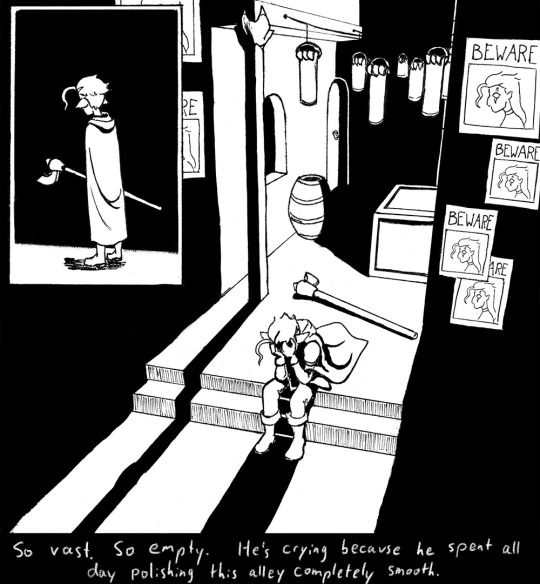
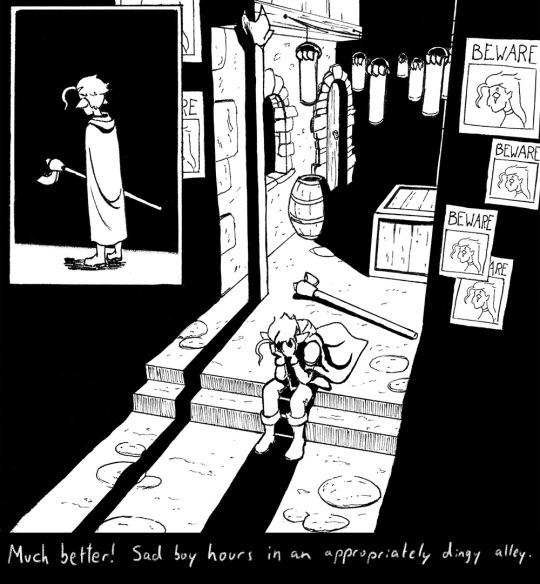
Line weight
Darker, thicker lines draw more attention, look heavier, and look closer to the viewer than lighter, thinner lines do. Take advantage of this to draw the viewer's attention to your focal points, de-emphasize less important details, and imply depth. It's up to you to decide how you want to use this and what your style is, especially once you start getting into combining or replacing it with shading, values, and color, but a helpful rule of thumb is to try reserving your thickest lines for focal foreground characters and use thinner lines on backgrounds, especially details in the far distance.
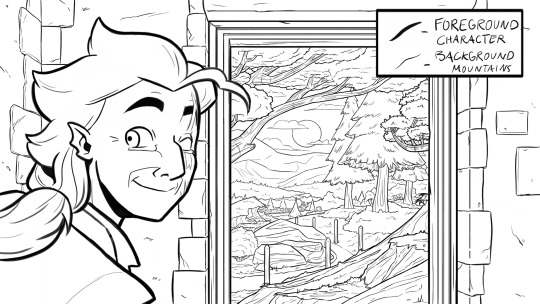
Perspective guides
If you're drawing digitally, take full advantage of any perspective tools you have access to! A lot of art programs lately have begun adding perspective guide features that let you set up vanishing points and then literally guide your hand as you draw so you stay in perspective. Some of these include Procreate, Clip Studio Paint, and Adobe Fresco. (still sadly none in Photoshop as far as I'm aware, what the heck, Adobe!). Check through the settings of yours to see if it gives you any perspective guides or other similarly useful tools. They're 100% worth it! And for god's sake, if you've got any skew or perspective warp tools, draw your complicated shapes flat and then warp them instead of spending an hour on it! Don't make my mistakes!
#backgrounds#art tips#tutorial#art reference#drawing tips#perspective drawing#the owl house#hunter toh#doodle art#doodletext#rambling topic#yes i'm using my blorbo to demonstrate art tips what about it#this took longer than i meant it to lol. i got really into the examples#thank you for your patience guys#this turned out to be a GREAT exercise for me as an artist too actually. Trying to explain things is rlly good practice#I didn't even get into values and such. I can only ramble so much I'm afraid
828 notes
·
View notes
Text
"Beyond the Veil: Illuminating 'The Human Aura' by Swami Panchadasi (William Walker Atkinson)"
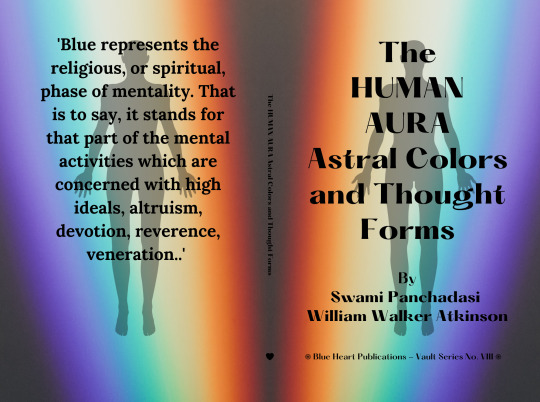
Swami Panchadasi, the pseudonym for the prolific William Walker Atkinson, beckons readers into the ethereal realm of metaphysics and mysticism with his profound work, "The Human Aura: Astral Colors and Thought Forms." This timeless exploration of the invisible energies that surround and emanate from the human body offers a captivating journey into the esoteric dimensions of our existence. The title alone hints at the unveiling of the unseen, promising a rich tapestry of insights into the intricacies of the human aura.
Atkinson's expertise in the realms of mysticism and the occult is evident as he guides readers through the subtle yet profound aspects of the human aura. The aura, believed to be an electromagnetic field that encapsulates the physical body, is described in vivid detail by Panchadasi. The astral colors and thought forms, according to his teachings, provide a visual representation of an individual's emotional, mental, and spiritual state.
The language employed by Panchadasi is both accessible and poetic, allowing readers to grasp the complexities of metaphysical concepts without feeling overwhelmed. The intricacies of astral colors, thought vibrations, and the interplay between the physical and spiritual realms are presented in a manner that invites contemplation and introspection.
One of the notable strengths of "The Human Aura" is its practical approach. Panchadasi not only describes the theory behind the human aura but also provides exercises and techniques for readers to develop their own sensitivity to these subtle energies. The inclusion of practical applications enhances the book's value, allowing readers to engage with the material on a personal level.
The title characterizes the human aura as a dynamic canvas that reflects the inner workings of the mind and spirit. Panchadasi introduces readers to the idea that thoughts and emotions are not mere intangible concepts but possess a tangible existence in the form of vibrant colors within the aura. This perspective encourages individuals to become more attuned to their inner states and, subsequently, take charge of their spiritual and mental well-being.
However, it is essential to approach Panchadasi's work with an open mind, recognizing that the exploration of the aura and thought forms is rooted in esoteric traditions. The book delves into areas that might challenge conventional beliefs, urging readers to broaden their perspectives on the nature of reality and the interconnectedness of the physical and metaphysical realms.
In conclusion, "The Human Aura: Astral Colors and Thought Forms" by Swami Panchadasi, alias William Walker Atkinson, is a captivating odyssey into the unseen dimensions of human existence. The title, with its promise of exploring astral colors and thought forms, encapsulates the essence of the work. Panchadasi's eloquent prose, coupled with practical exercises, invites readers to embark on a personal journey of self-discovery and heightened awareness. As one delves into the pages of this mystical masterpiece, the invisible threads of the human aura are unraveled, revealing a world that transcends the limits of the physical and invites us to contemplate the boundless potential of the human spirit.
"The Human Aura: Astral Colors and Thought Forms." , is available in Amazon in paperback 12.99$ and hardcover 18.99$ editions.
Number of pages: 91
Language: English
Rating: 8/10
Link of the book!
Review By: King's Cat
#Swami Panchadasi#William Walker Atkinson#The Human Aura#Astral Colors#Thought Forms#Metaphysics#Mysticism#Esoteric traditions#Invisible energies#Spiritual exploration#Vibrant colors#Inner states#Astral dimensions#Electromagnetic field#Spiritual well-being#Practical exercises#Introspection#Personal development#Esoteric insights#Metaphysical concepts#Inner workings of the mind#Subtle energies#Dynamic canvas#Spiritual journey#Mind and spirit#Open-minded exploration#Interconnectedness#Unseen dimensions#Transcendental experiences#Spiritual awakening
3 notes
·
View notes
Text
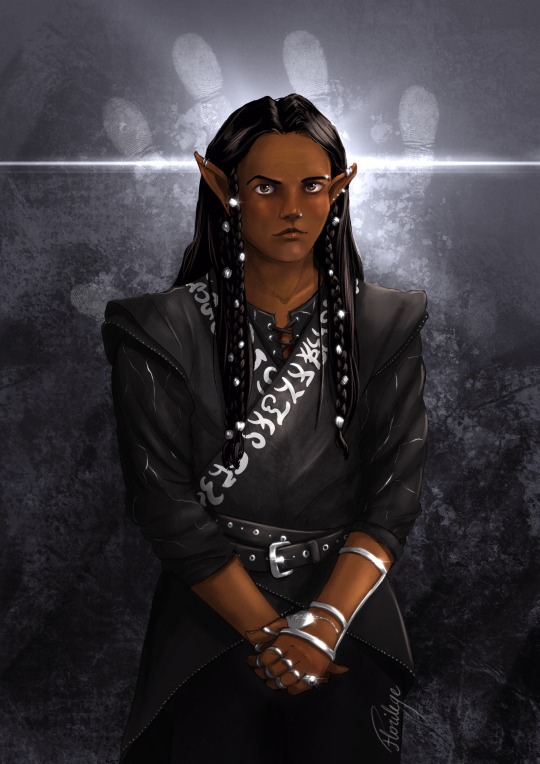
We needed Celebrimbor as Dalamar, to go with Annatar as Raistlin and Finrod as Crysania.
He could also double as book!Dalamar, tbh. But because it's my Celebrimbor design, he's wearing the silver ring splints I've drawn for him before.
for @chthonion and @actual-bill-potts 💙
#celebrimbor#silmarillion#tolkien#tyelpe#dalamar#dalamar argent#the last trial#dragonlance#echo's drawings#i'm really happy with him#i've been so sick the last few days and screens were making it worse#so it took a while#i'm happy i could finally finish him today#i think he's the last of the series#i'm not drawing morgoth as takhisis lol#also drawing photo studies for a while actually made me progress at drawing faces?#who knew practice and exercises could help?#*facepalm*
89 notes
·
View notes
Text
"Unveiling the Unseen: A Profound Exploration of 'Clairvoyance and Occult Powers' by Swami Panchadasi"

Title: "Unveiling the Unseen: A Profound Exploration of 'Clairvoyance and Occult Powers' by Swami Panchadasi"
Swami Panchadasi's (A.K.A. Atkinson, William Walker) "Clairvoyance and Occult Powers" beckons readers into the enigmatic realms of extrasensory perception and mystical abilities. As I delved into the pages of this esoteric work, I found myself immersed in a fascinating journey through the intricacies of clairvoyance, the third eye, and the untapped potentials of the human mind. The title alone promises a profound exploration of occult powers, and Swami Panchadasi does not disappoint.
At the heart of the book lies an in-depth exploration of clairvoyance, the ability to perceive beyond the limitations of the physical senses. Swami Panchadasi, drawing upon his deep knowledge of Eastern mysticism, unveils the secrets of developing and harnessing this psychic faculty. His teachings guide readers through the nuances of opening the third eye, awakening dormant powers, and tapping into the unseen forces that permeate our existence.
One of the notable strengths of Panchadasi's work is its accessibility. Despite delving into intricate metaphysical concepts, the author presents the material in a manner that is comprehensible to both novices and seasoned practitioners. The step-by-step instructions and practical exercises provided serve as a roadmap for individuals seeking to cultivate their latent psychic abilities.
The book also delves into various occult powers beyond clairvoyance, offering insights into telepathy, psychometry, and the manipulation of vital life forces. Panchadasi's approach is not merely theoretical; he provides practical exercises and guidance, inviting readers to embark on a personal journey of self-discovery and spiritual development.
What sets "Clairvoyance and Occult Powers" apart is its blend of Eastern mysticism and Western occultism. Swami Panchadasi draws from a diverse range of spiritual traditions, creating a synthesis that resonates with a broad audience. The inclusion of anecdotes, case studies, and historical references adds depth to the narrative, illustrating the universality of these mystical experiences.
While the subject matter may challenge conventional beliefs, Panchadasi approaches it with a sense of reverence and responsibility. The emphasis on ethical considerations and the cautionary advice regarding the use of occult powers underscore the author's commitment to guiding readers toward a balanced and mindful exploration of these mystical realms.
In conclusion, "Clairvoyance and Occult Powers" by Swami Panchadasi is a captivating exploration of the unseen dimensions of human potential. Whether one approaches it with skepticism or an open mind, the book offers a thought-provoking journey into the realms of the mystical and the metaphysical. Panchadasi's lucid prose, coupled with practical exercises, makes this work an invaluable resource for those curious about unlocking the hidden potentials of the mind and delving into the mysteries that lie beyond the veil of the material world.
Swami Panchadasi's (A.K.A. Atkinson, William Walker) "Clairvoyance and Occult Powers" is available in Amazon in paperback 14.99$ and hardcover 22.99$ editions.
Number of pages: 324
Language: English
Rating: 10/10
Link of the book!
Review By: King's Cat
#Swami Panchadasi#Clairvoyance#Occult powers#Third eye#Extrasensory perception#Mystic abilities#Eastern mysticism#Psychic faculties#Spiritual development#Metaphysical exploration#Practical exercises#Mystical experiences#Awakening the third eye#Psychometry#Telepathy#Vital life forces#Eastern and Western occultism#Self-discovery#Ethical considerations#Unseen dimensions#Hidden potentials#Mind-body connection#Occult practices#Astral perception#Meditation techniques#Metaphysical concepts#Personal transformation#Mystical traditions#Practical guidance#Spiritual growth
0 notes
Text
I Am That remix: Only hold on to 'I AM'

Don’t you see that it is your very search for happiness that makes you feel miserable? If you want to make real progress, you must give up all ideas of personal attainment. Your burden is of false self-identification – abandon them all. All that is needed is to purify the mind so that it can realize its identity with the Self. When the mind merges in the Self, the body presents no problems.
Try it this way: indifferent to pain and pleasure, neither seeking, nor refusing, give all your attention to the level on which ‘I am’ is timelessly present. Just look away from all that happens in your mind and bring it to the feeling ‘I am’. Refuse all thoughts except one: the thought ‘I am’. Just keep in mind the feeling ‘I am’, merge in it, till your mind and feeling become one. Separate consistently and perseveringly the ‘I am’ from ‘this’ or ‘that’ and try to feel what it means to be, just to ‘be’, without being ‘this’ or ‘that’. Give up all ideas about yourself and simply be. Stop making use of your mind and see what happens. Do this one thing thoroughly, that is all. The best is the simple feeling ‘I am’. Dwell on it patiently.
The mind will rebel in the beginning, but with patience and perseverance, it will yield and keep quiet. Here patience is wisdom; don’t think of failure. There can be no failure in this undertaking. By repeated attempts you will stumble on the right balance of attention and affection and your mind will be firmly established in the thought-feeling ‘I am’. When this mind becomes completely silent, it shines with a new light and vibrates with new knowledge. Once you are quiet, things will begin to happen spontaneously and quite naturally, without any interference on your part. Once you realize that all happens by itself (call it destiny or the will of God or mere accident), you remain as witness only, understanding and enjoying, but not perturbed. Whatever you think, say or do, this sense of immutable and affectionate being remains as the ever-present background of the mind. When you can see everything as it is, you will also see yourself as you are. It is like cleansing a mirror. The same mirror that shows you the world as it is will also show you your own face (Self). The thought ‘I am’ is the polishing cloth. Use it. Give your heart and mind to it, think of nothing else.
All the glories will come with mere dwelling on the feeling ‘I am’. It is the simple that is certain, not the complicated. Somehow, people do not trust the simple, the easy, the always available. Why not give an honest trial to what I say? It may look very small and insignificant, but it is like a seed that grows into a mighty tree. Give yourself a chance.
If you want to know your true nature, you must have your Self in mind all the time, until the secret of your being stands revealed. Soon you will realize that peace and happiness are in your very nature and it is only seeking them through some particular channels that disturbs. All will happen by itself. You need not do anything, only don’t prevent it. It all comes spontaneously; you need only to hold on to the ‘I am’. It is very much like digging a well. You reject all that is not water, till you reach the life-giving spring.
from I Am That (mashup of selected quotes from 1 to 79 of "The complete ‘I Am’ quotes of Sri Nisargadatta Maharaj")
#still on break-not back yet#highlight key: purple for 'action' points - pink for key points#excerpts#remix#i am that#nisargadatta maharaj#practical#exercise#witnessing
218 notes
·
View notes
Note
Saw your Mishanks bodyswap art! Very cute and fun! (Mihawk with a genuine smile on his face so so fun)
I imagine Shanks whould have trouble fighting in Mihawk's body at first since it's been years since he's had two arms
yes absolutely, i imagine that too! conversely, i think mihawk would have a little bit of trouble adjusting his balance and reach with a body missing one arm, as well. it's interesting to think about how they both would be forced to change their fighting style, and whether or not they would exchange swords.
mihawk's been seen using yoru with just one hand so he could probably pull it off with shanks's body. also interesting to think about shanks tripping up on having two arms until he naturally slips into his old fighting style again--or would he? because there's also the question of muscle memory, right? would mihawk's body automatically do things that shanks isn't predisposed to doing, and vice versa?
the other thing i find intriguing about body swapping in one piece is the question of whether or not your haki powers would switch as well. they say haki is spiritual presence, so presumably your haki switches if your spirits switch, but if it's the kind of spirit that's tethered to the presence of the body? then consider mihawk having the strongest conqueror's haki out on the blues, or shanks being able to use observation haki at mihawk's level, practically being able to predict the future--or mihawk, able to counter with shanks's haki-kill technique. food for thought!
#rei replies#one piece#mishanks body swap au#mishanks#akataka#dracule mihawk#shanks#akagami no shanks#red haired shanks#re: the genuine smiling#i also like to think shanks in mihawk's body would have this moment where he realizes his cheeks ache from all the smiling he's doing lol#bc mihawk's facial muscles arent used to doing it#and when they switch back shanks teases mihawk about it ('you exercise so many of your muscles hawky but your cheeks? they're weak!')#and he manages to get a smile out of mihawk that's mihawk's version of a genuine smile and it's softer and less wide but it's honest#and oh shanks is soooooo in love with him hahaha#BY THE WAY ALSO I JUST THOUGHT OF THIS OMG but in this body-swapped au mihawk-as-shanks would 100% shave for shanks#like hell is he gonna let shanks grow *stubble* on *his* face. dracule mihawk with STUBBLE? banish the thought!!!!!!#but shanks doesnt do it up to his standards so there's totally a scene where mihawk and shanks are body swapped in the bathroom#and mihawk is standing too close and shaving his lil pointy sideburns and mustache onto shanks's face#and shanks is having a crisis because that's his own face breathing too close and waaaay to intimately but that look of concentration#is ALL mihawk. shanks can practically his eyes--so familiar from the mirror and wrinkled with laugh lines--glow yellow with how#much mihawk looks like himself right now even in shanks's body.#it's all very strange. shanks has been attracted to mihawk for a long time but it's just blatantly unfair that the first time in YEARS#theyre this close again and it's shanks's own body that he has to look at. on the upside he supposes all he needs to do to ogle#mihawk is to look down. pros and cons pros and cons.#(mihawk isnt having a crisis. mihawk is annoyed that hia beard is easier to do in first person it is to do in the third person.#surely not having to do it reflected in a mirror should be easier and yet for some reason everything feels off! ugh.)#i digress
63 notes
·
View notes